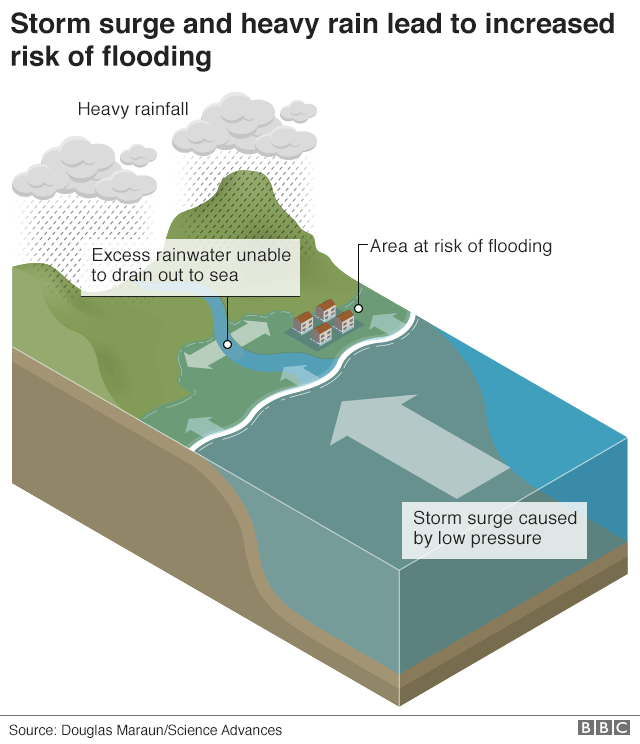Some of the European low-lying coastal areas and river estuaries may see a future increase in flooding caused not only by sea-level rise but also by more frequent concurrent storm surge and heavy precipitation, we show in a new study published in Science Advances [1].

Coastal flood risk is usually calculated based on storm surge and extreme rainfall hazards separately. However, ignoring compound flooding arising from the local interaction between these two hazards may cause severe underestimation of the actual flooding risk in some areas.
The importance of considering compound flooding for planning coastal defences is shown, for example, by the past flooding management in Lymington [3], a port town in the southern UK. As discussed by Hendry et al. [3], in December 1989, a storm surge led to widespread flooding in the town, causing damages to houses and the railway line. As a result, an extensive upgrade of the coastal defences took place; however, the potential for flooding resulting from the interaction of storm surge and pluvial flooding was not considered at that time. Ten years later in 1999, the Christmas Eve in Lymington was stormy: a cyclone not only caused a storm surge but, simultaneously, also very heavy rainfall leading to high discharge in the Lymington River. The new raised defences were activated and protected the town from the storm surge well; however, the prolonged storm surge did not allow the sea defences to be deactivated, thus trapping the water discharge of the Lymington River on the upstream side of the sea defences. This combination of events resulted in very deep flooding over the railway line and into residential and commercial development in Lymington.

Similar compound flooding happened, for example, in 2012 in The Netherlands [4], and in 2015 in Ravenna (Italy) [2] due to the cyclone Norbert causing concurring heavy rainfall and storm surge. In fact, coastal heavy rain often coincides with a storm surge because these two hazards frequently result from the passage of a cyclone. Thus, considering only one of the two hazards at a time, or assuming that they are independent, can result in a substantial underestimation of the flooding risk.
It is clear that in low-lying coastal areas and river estuaries, compound flooding should be considered to avoid underestimating the flooding risk. However, the need for considering the multiple flooding drivers simultaneously makes compound flooding risk assessment a rather complicated task. In addition, as climate changes, we need to understand how the compound flooding risk will change in the future, which is vital for adapting to flooding changes through – when necessary – building or upgrading flood defences. Thus, also future changes in sea level and precipitation need to be taken into account when assessing the flooding risk, making a compound flooding assessment extremely challenging.
In a new study, colleagues and I investigated, for the first time, how compound flooding may change in the future due to sea-level rise and changes in precipitation, storm surge, and their interaction.
Focussing on the European and North African coasts, we found that not only sea-level rise will cause an increase in the potential for compound flooding everywhere, but additional changes in compound flooding will be caused by changes in storms. In particular, the potential for compound flooding is projected to increase in northern Europe due to increasing precipitation intensities, mainly caused by a future warmer atmosphere that allows storms to carry more moisture.
The results of the study cannot be interpreted as a precise assessment of the local flooding risk, though it is evident that compound flooding will become more likely in the future if we do not take any action against climate change. The study aims at offering a large-scale view of the present and future potential for the compound flooding hazard. Identifying European regions potentially facing compound flooding in a warmer climate, it provides a basis for follow-up local compound flooding risk assessments and adaptation planning.
In locations prone to compound flooding, adapting to sea-level rise only might be insufficient, and additional changes in precipitation, storm surges, and their interaction should be considered to avoid too optimistic adaptation planning.
Emanuele Bevacqua
Originally posted on the Meteorology blog of the University of Reading.
References
[1] Bevacqua, E., D. Maraun, M. I. Vousdoukas, E. Voukouvalas, M. Vrac, L. Mentaschi, and M. Widmann, 2019: Higher probability of compound flooding from precipitation and storm surge in Europe under anthropogenic climate change. Science Advances, 5, no. 9, eaaw5531, https://doi.org/10.1126/sciadv.aaw5531.
[2] Bevacqua, E., D. Maraun, I. Hobæk Haff, M. Widmann, and M. Vrac, 2017: Multivariate statistical modelling of compound events via pair-copula constructions: analysis of floods in Ravenna (Italy). Hydrology and Earth System Sciences, 21, no. 6, 2701-2723, https://doi.org/10.5194/hess-21-2701-2017.
[3] Hendry, A., I. Haigh, R. Nicholls, H. Winter, R. Neal, T. Wahl, A. Joly-Laugel, and S. Darby, 2019: Assessing the characteristics and drivers of compound flooding events around the UK coast. Hydrology and Earth System Sciences, 23, 3117-3139, https://doi.org/10.5194/hess-23-3117-2019.
[4] van den Hurk, Bart, Erik van Meijgaard, Paul de Valk, Klaas-Jan van Heeringen, and Jan Gooijer, 2015: Analysis of a compounding surge and precipitation event in the Netherlands. Environmental Research Letters, 10, no. 3, 035001, https://doi.org/10.1088/1748-9326/10/3/035001.

